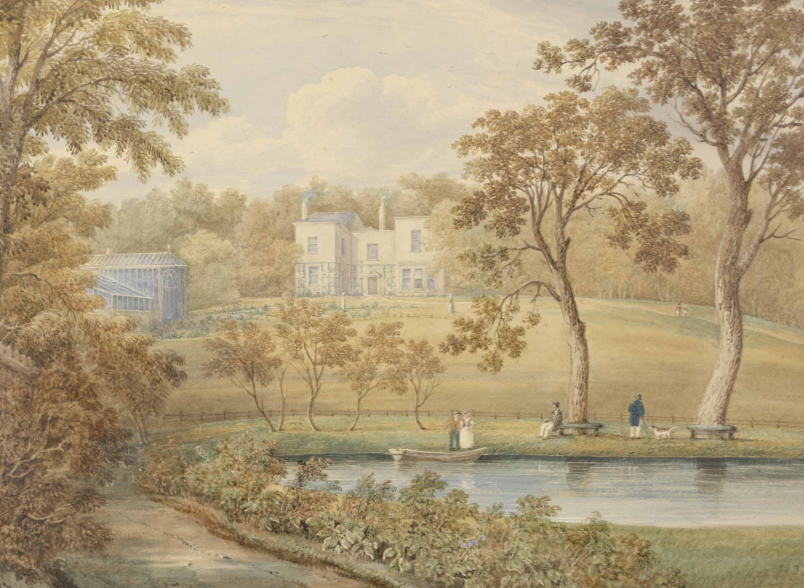Hardy Plants and Plantings for Repton and Late Georgian Gardens (1780-1820)

|
| Hardy Plants and Plantings for Repton and Late Georgian Gardens (1780-1820), Sarah Rutherford, Historic England, Research Report Series No 20-2018, 39 pages, 21 colour and black and white illustrations, available as a free-to-download 5.31 MB pdf file at http://research.historicengland.org.uk/Report.aspx?i=16017 |
In 2018, the garden history world focused on Humphry Repton (1752–1818), the great landscape designer and successor to Lancelot ‘Capability’ Brown (1716-83). This report aims to provide a starting point for anyone involved with planting, managing or researching a late-Georgian garden, and a contribution to the celebrations.
Repton was not the only designer in the period, but he was prolific and a great self-publicist, leaving a legacy of books and individual reports to clients. The reports, often bound in red leather and now known as Red Books, included watercolours with lift-up flaps showing scenes before and after implementation of his advice. Often his advice was not followed.
Although skilled in proposed effects, Repton was no plantsman. He and others published little detailed planting advice. The report aims to remedy this by considering plants available in the period and how they were used, and sources for further research. Garden historian and Kew-trained Sarah Rutherford rises to the challenge. She has prepared many conservation plans, including one for Ashridge (Repton’s Red Book partly illustrates the report), and her books include ‘Capability Brown’ and ‘The Arts and Crafts Garden’.
An overview of garden design in 1780-1820 includes the return (where it ever went away) of the flower garden around the house and the need for elegant gardens to complement the many new smaller houses in pared-down classical style. The numerous picturesque cottages ornés are not specifically mentioned, although Endsleigh in Devon is illustrated.
The standard palette was augmented by many, at first expensive, plants introduced from exotic places. The new planting style was to mass plants of the same type for visual impact. Shrubberies became distinctive features with splashes of colour and year-round interest. Separate themed areas included the specialist rose garden. The modern publications of Mark Laird, Mavis Batey and John Harvey are correctly highlighted as essential resources.
The main section lists 338 ornamental hardy plants available in Britain between 1780 and 1820, and still readily available, grouped by type with Latin and common names, some dates of introduction and notes on colour. The list is obviously drawn from many sources, including (it can be deduced) a 1778 seed catalogue. The researcher would have welcomed details of sources and criteria. The snap dragon introduced ‘by 1778’ might be mistakenly thought a new exotic (elsewhere John Harvey gives a date of c1500).
Three case studies, Brighton Royal Pavilion, a Jersey town house and the Ashridge flower garden, are described. Planting lists for the last two include later varieties to produce a period effect. This highlights a point, not discussed, that planting is inevitably re-creation rather than restoration, a term sometimes confused. The references of primary and secondary sources for further research demonstrate the wealth of information readily available, although with critical appraisal wisely advised.
Given such a concise summary of current knowledge and horticultural experience, some quibbles are inevitable. Overall, for any late Georgian garden project this report is a very good starting point and a useful checklist for the future.
You can download the report at http://research.historicengland.org.uk/Report.aspx?i=16017
This article originally appeared in IHBC's Context 156 (Page 53), published in September 2018. It was written by Helen Thomas, a retired architect and historic designed landscape consultant.
--Institute of Historic Building Conservation
Related articles on Designing Buildings Wiki
- Capability Brown.
- Conservation.
- Conserving and managing historic designed landscapes.
- Conserving structures in historic designed landscapes.
- Garden.
- Georgian.
- Heritage.
- IHBC articles.
- Landscape architect.
- Landscape design.
- Oxford College Gardens and Cambridge College Gardens.
- Picturesque movement.
- Sharawadgi.
- The Institute of Historic Building Conservation.
- The secret life of the Georgian garden.
- Walled kitchen gardens of the Isle of Wight.
- Worcester’s Georgian churches.
IHBC NewsBlog
Old Sarum fire in listed (& disputed) WW1 Hangar - Wiltshire Council has sought legal advice after fire engulfed a listed First World War hangar that was embroiled in a lengthy planning dispute.
UK Antarctic Heritage Trust launches ‘Virtual Visit’ website area
The Trust calls on people to 'Immerse yourself in our heritage – Making Antarctica Accessible'
Southend Council pledge to force Kursaal owners to maintain building
The Council has pledged to use ‘every tool in the toolbox’ if urgent repairs are not carried out.
HE’s Research Magazine publishes a major study of the heritage of England’s suburbs
The article traces the long evolution of an internal programme to research 200 years of suburban growth
IHBC Context 183 Wellbeing and Heritage published
The issue explores issues at the intersection of heritage and wellbeing.
SAVE celebrates 50 years of campaigning 1975-2025
SAVE Britain’s Heritage has announced events across the country to celebrate bringing new life to remarkable buildings.
IHBC Annual School 2025 - Shrewsbury 12-14 June
Themed Heritage in Context – Value: Plan: Change, join in-person or online.
200th Anniversary Celebration of the Modern Railway Planned
The Stockton & Darlington Railway opened on September 27, 1825.
Competence Framework Launched for Sustainability in the Built Environment
The Construction Industry Council (CIC) and the Edge have jointly published the framework.
Historic England Launches Wellbeing Strategy for Heritage
Whether through visiting, volunteering, learning or creative practice, engaging with heritage can strengthen confidence, resilience, hope and social connections.














